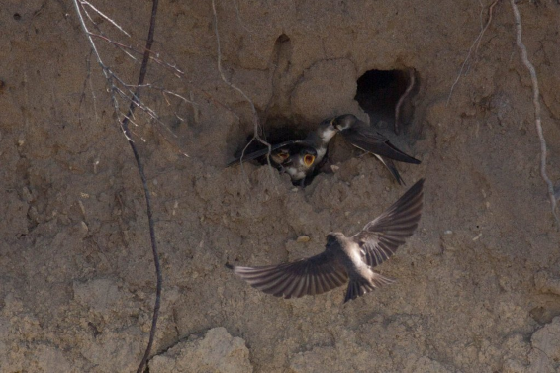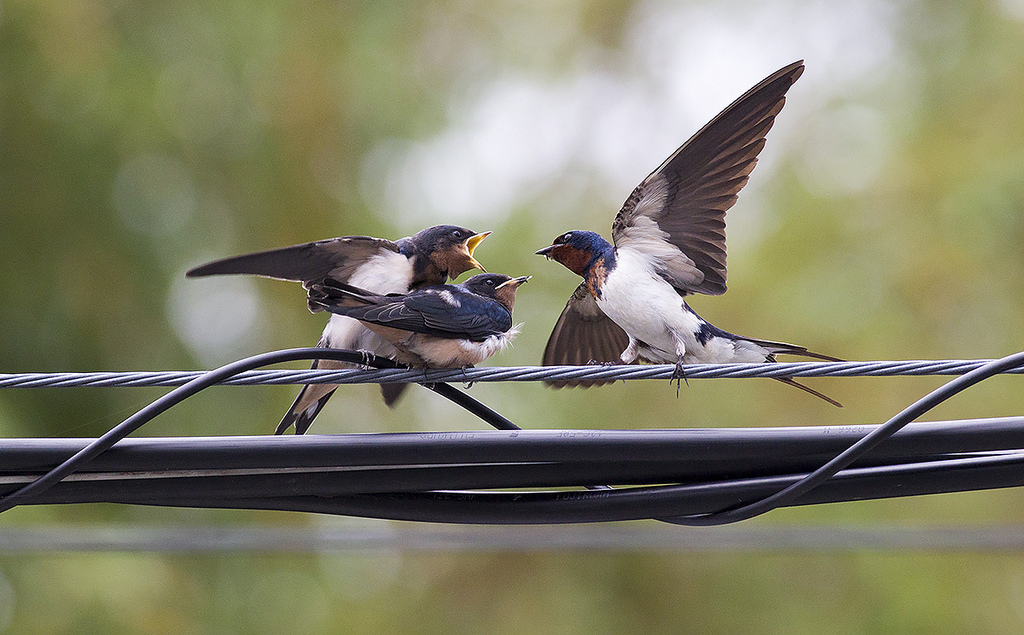Like this article? rabble is reader-supported journalism. Chip in to keep stories like these coming.
Forty years ago, swallows were a common sight in the summer, darting between the beams of old barns or swooping low over the waters of a creek. These swift aerial acrobats seemed to be everywhere — perched on telephone lines by the dozen awaiting the fall migration, or whirling and diving around old wooden bridges in pursuit of airborne insects.
Now, these birds have seemingly disappeared from midair, entirely abandoning large swathes of their former Canadian range. Some, like the bank swallow, have seen their numbers plummet by 98 per cent since 1970. They’ve become the centre of one of Canada’s greatest biological mysteries, and scientists are scrambling to discover why.
The swallows’ disappearance is part of a larger trend affecting birds known as aerial insectivores, which spend much of their lives on the wing in a constant search for airborne insects to dine on. This group, which includes chimney swifts, purple martins, and whippoorwills, has plunged by 70 per cent in population in Canada, according to a 2012 report by the North American Bird Conservation Initiative. Many birds in this category are now listed as threatened in Canada.
But although the exact cause for this decline is unknown, signs of their disappearance are everywhere for those who know where to look.
“Algonquin Park used to have barn swallows nesting on every bridge,” says Michael Runtz, a naturalist and instructor at Carleton University. “They were abundant, nesting everywhere…they’re all gone now.”
Slipping away in secret
But despite populations dropping off, change has been hard to spot.
Myles Falconer is a biologist at Bird Studies Canada, a not-for-profit organization dedicated to the study of Canadian bird populations. He’s studied bank swallows since 2010, and penned a 2014 report on the birds for the federal Committee on the Status of Endangered Wildlife in Canada. Forty years ago, these tenacious burrowing birds numbered over 70 million individuals. Now, a scant 1.4 million remain — a survival rate of two per cent. Despite this decades-long decline, they were only designated as threatened in 2013, after COSEWIC researchers watched a third of the population disappear in under a decade.
Falconer says this is the case for many aerial insectivores, which have been neglected in most scientific studies because of how large their colonies appear.
“They’re widespread and common still, and they’re so widespread and common that nobody has done any really intensive work on them, he says.
“There’s still thousands of bank swallows, so it’s difficult to see a difference between thousands and hundreds of thousands.”
Despite this apparent abundance, another 3.65 per cent of the population is lost each year. And although a federal bank swallow recovery strategy is in the works, Falconer says it will only attempt to halt the population decline. It’s unlikely the bank swallows will ever be able to rebound to their 1970 numbers.
As evidence of aerial insectivores’ decline mounts, scientists are struggling to distil a plethora of theories to a single proven cause. Global warming, changes in insect populations, habitat loss, and pesticide use along traditional migratory routes have all been proposed as viable explanations, but as of yet, no one has identified the underlying cause for the aerial insectivores’ disappearance.

Bank swallows in a riverbank. These birds have seen their populations decline by more than 90 per cent.
Deadly Dining
But although many theories are species-specific, there’s one factor that ties all aerial insectivores together — their food source.
“There’s a lot of biomass in the sky at certain times of the year, and they all feed on it,”says Falconer. “It’s kind of an underreported ecosystem in a way; the sky is definitely full of life.”
Though a relatively new concept, change in this airborne ecosystem has become one of the dominant theories as to the birds’ disappearance.
Chris Grooms, a paleoecologist at Queen’s University, tested the possible correlation between changing insect populations and the disappearance of aerial insectivores using chimney swifts, whose numbers have plummeted by 96 percent in the last 45 years.
“The only thing that links them all is food,” Grooms says. “They catch insects on the wing. They do it differently, with different habitats, but they’re catching them all on the wing.”
To assess dietary changes in swift populations, Grooms and his team excavated two meters of the birds’ droppings — representing about 50 years’ worth of dietary information — from inside an old chimney at Queen’s University’s Flemming Hall.
He found the chimney swifts switched their diet from nutritious beetles to less-substantial flying insects like mosquitoes when the use of DDT, a once-popular insecticide that was banned in Canada in 1972, was at its peak. It targeted the crop-hungry beetles, and forced a switch to less-nutritional food that coincided with the birds’ decline.
Grooms says the forced change in diet likely depleted the birds’ energy and limited their ability to breed. However, he maintains that the more research must be done before any overarching conclusions can be made for all aerial insectivores.
“A lot more funding, a lot more time and energy should be spent on that type of study, to really assess what’s happening,” he says.
“It’s part of the bigger picture with aerial insectivores. Are pesticides used in agricultural areas causing insect eating birds in general to decline?”
Carl Savignac, a terrestrial wildlife biologist from Chelsea, Que., penned a 2011 COSEWIC report on the national status of barn swallows. He says the birds’ decline stems from a combination of factors, but that changes in agricultural practices have likely had a profound impact.
“Along the St. Lawrence River in Quebec and through Ontario we see mainly a corn and soy culture, and most of the pasture land has disappeared or really decreased,” he says. “If you replace pasture land with intensive agriculture like corn and soy, you lose most of the insect diversity.”
This is because pasture land is typically free of pesticides, and the abundance of herd animals attracts insects in droves.
If changes in insect populations really are the problem, it will make stopping the decline of aerial insectivores even more difficult.
“We don’t know a lot about insects,” says Grooms. “There are lots of ideas and theories, but we don’t have great data on insects. The chimney swifts are the only ones who have really left a record of what insects have been in the environment over longer time periods.”
Though insect populations are now a recognized area of study, Grooms says that like aerial insectivores, they have largely been ignored in the past. The absence of historic data and the difficulty in assessing insect populations across the birds’ vast range present significant challenges in establishing a solid link between the two groups.
A Band-Aid solution
Despite insect populations’ growing importance in the mystery of the insectivores’ disappearance, conservation efforts have largely focused on habitat loss.
It’s a one-size-fits-all solution, and it’s not without flaw. Falconer says the bank swallows aren’t losing habitat — in fact, their decline can be seen in as a large swath of vacant habitat stretching across Canada.
Kristyn Richardson is the volunteer coordinator of Bird Studies Canada’s Swiftwatch Program, which monitors over 800 chimneys in Ontario to protect chimney swift habitat. Richardson says the focus has been on preserving habitat largely because it’s a tangible solution to the birds’ decline.
“Even though there has been a strong focus on habitat and habitat loss, we’re starting to realize definitely that habitat may not be the only cause, or even the biggest cause of the declines,” she says.
“And I think that’s why the focus has been on habitat, especially on the breeding grounds, because there is something we can do. So there are tangible outcomes, versus if it is insects, and it most likely is insects, so what do you do? How do you solve that problem? It’s the million dollar question.”
To make up for decades of lost study, researchers across North America are now conducting studies on insect populations in relation to aerial insectivore declines. But each year, hundreds of thousands of these birds continue to disappear. According to a 2013 federal report, the remaining bank swallows face a 20 per cent chance of extinction within the next 18 years.
The data may be startling, but Grooms says the results are visible all around us.
“Even 25 years ago, there were tree swallows on wires in the fall by the thousands and thousands. And you don’t see that anymore. You see two dozen at most, at migration time. So until we can figure out some of the real causes, they’re just going to continue to decline. There’s no reason to assume things will change on their own.”

Jen Halsall is studying journalism and history at Carleton University in Ottawa. She is a passionate environmentalist with a penchant for science reporting and a soft spot for “all that is green and good.” You can find her on twitter as @Jennhalsall. She is rabble’s 2015-16 blogs intern.
Like this article? rabble is reader-supported journalism. Chip in to keep stories like these coming.



